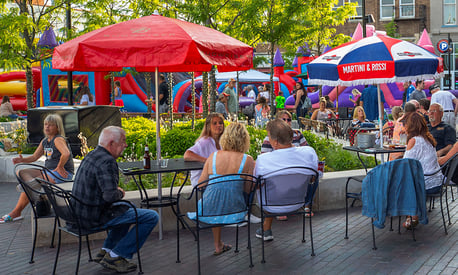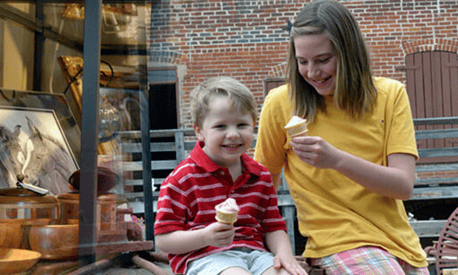Our Communities
Hoosier Hospitality
Along the I-74 Business Corridor
Nestled within a beautiful countryside, communities along the I-74 Business Corridor offer the best in Midwest culture and values. Our people and businesses benefit from:
- Peaceful and safe places where families grow and thrive.
- Schools with graduation rates beyond 90 percent.
- A strong sense of community with a variety of recreation and extracurricular activities.
With Indianapolis and Cincinnati nearby, our communities enjoy the best of both worlds – a warm and friendly small-town atmosphere with easy access to metropolitan shopping and dining, museums, professional sports and endless entertainment options.
 A vibrant community of over 7,200 and growing, Batesville, Indiana is home to independent and hardworking entrepreneurs. Supported by our rural roots, we seek to uphold our growing economy, innovative spirit, and community pride for generations to come.
A vibrant community of over 7,200 and growing, Batesville, Indiana is home to independent and hardworking entrepreneurs. Supported by our rural roots, we seek to uphold our growing economy, innovative spirit, and community pride for generations to come.
History
Batesville was founded in 1852, thanks to the arrival of the Cincinnati and Indianapolis Railroad. The town was named after Teunis Amack Bates, a local landowner who sold land to the railroad company, sparking its development. Originally a small railroad town, Batesville quickly grew into a hub for manufacturing.
Demographics
As of 2023, Batesville has an estimated population of approximately 6,842 residents. The median age is 38.9 years, with about 27.4% of the population under 18 and 19.8% aged 65 or older.
Infrastructure
Batesville has developed a comprehensive green infrastructure plan focusing on sustainable stormwater management, urban forestry and eco-friendly development practices.
Economy
Batesville is home to major manufacturing firms, including Batesville Casket Company, a leading U.S. casket manufacturer, and Hillrom, known for producing hospital beds and healthcare equipment. Additionally, Batesville Tool & Die contributes to the city's industrial base.
 Dearborn County, located in the southeastern part of the state along the Ohio River, is part of the Cincinnati metropolitan area. The county seat and largest city is Lawrenceburg.
Dearborn County, located in the southeastern part of the state along the Ohio River, is part of the Cincinnati metropolitan area. The county seat and largest city is Lawrenceburg.
History
Established in 1803, Dearborn County was named after General Henry Dearborn, who served as Secretary of War under President Thomas Jefferson. The county's boundaries were finalized in 1845 after portions were used to create several other counties. Lawrenceburg, founded in 1802.
Demographics
As of 2023, Dearborn County has an estimated population of approximately 50,828 residents. The median age is 41.8 years, which is slightly higher than the state and national averages. The county has experienced modest population growth over the past decade.
Economy
Dearborn County's economy is diverse, encompassing manufacturing, agriculture, and service industries. In 2023, the county's Gross Domestic Product (GDP) was approximately $2.42 billion. The median household income stands at $82,693, reflecting a 2.91% increase from the previous year.
Geography and Infrastructure
Covering an area of about 307 square miles, Dearborn County features a mix of hilly and flat terrains, with fertile lands along the Ohio, Miami, and Whitewater rivers. Major transportation routes include Interstate 74, Interstate 275, and U.S. Routes 50 and 52, facilitating connectivity within the region.
VISIT
 Decatur County is located in southeastern Indiana and was established in 1822. It was named after Commodore Stephen Decatur Jr., a U.S. naval hero known for his service in the early 19th century. The county seat and largest city is Greensburg, which is notable for the tree that grows atop its courthouse tower.
Decatur County is located in southeastern Indiana and was established in 1822. It was named after Commodore Stephen Decatur Jr., a U.S. naval hero known for his service in the early 19th century. The county seat and largest city is Greensburg, which is notable for the tree that grows atop its courthouse tower.
History
The area that became Decatur County was part of the land acquired by the U.S. government through the Treaty of St. Mary's in 1818. The first settlers, including the Fugit and Griffith families, arrived shortly thereafter. The county was officially organized in 1822.
Geography and Demographics
Covering approximately 373 square miles, Decatur County features gently rolling hills primarily used for agriculture and urban development. The Flatrock River, Clifty Creek, and Sand Creek traverse the county, contributing to its natural landscape. As of the 2020 census, the population was 26,472.
Economy
Manufacturing stands as the cornerstone of Decatur County's economy, employing over 4,100 individuals. Notably, Honda Manufacturing of Indiana in Greensburg is the county's largest employer. Other significant employers include Delta Faucet Co., Valeo Engine Cooling Inc., and Baxter Healthcare. The county also benefits from foreign direct investment, hosting six Japanese-owned companies.
VISIT
 Franklin County is located on the eastern border of Indiana and is part of the Cincinnati Metropolitan Statistical Area.
Franklin County is located on the eastern border of Indiana and is part of the Cincinnati Metropolitan Statistical Area.
History
As the seventh county organized within Indiana's present limits, Franklin County was established in 1811. It played a significant role during Indiana's territorial period, with its formation preceding the state's admission to the Union
Demographics
Brookville serves as both the county seat and the largest town, with an estimated population of 2,643 as of 2023. The only incorporated city in the county is Batesville, which primarily lies in neighboring Ripley County. The county has experienced modest population growth, with an estimated increase from 22,790 in 2020 to 23,122 in 2025.
Economy
The workforce comprised approximately 11,200 individuals. The leading employment sectors include manufacturing, retail and healthcare. Tourism plays a pivotal role in Franklin County's economy. Brookville Lake, one of Indiana's most visited state parks, attracts over 1.3 million visitors annually.
LEARN MORE
 Nestled in the heart of Southeastern Indiana, Ripley County is a vibrant community rich in history, natural beauty, and hometown charm. From our picturesque rolling hills and scenic parks to our welcoming small towns and historic landmarks, Ripley County offers a unique blend of rural tranquility and cultural heritage.
Nestled in the heart of Southeastern Indiana, Ripley County is a vibrant community rich in history, natural beauty, and hometown charm. From our picturesque rolling hills and scenic parks to our welcoming small towns and historic landmarks, Ripley County offers a unique blend of rural tranquility and cultural heritage.
Economy
The economy is powered by diverse sectors, including advanced manufacturing, agribusiness, healthcare, and retail, supported by a skilled workforce and a pro-business environment.
Demographics
Ripley County is a predominantly rural area with a population of approximately 28,995 as of 2023, with 89.6% of residents aged 25 and over having at least a high school diploma. Employment is diversified across sectors such as manufacturing, healthcare, retail, and transportation
LEARN MORE
 Nestled in the heart of east-central Indiana, Rush County is a vibrant community rich in history, cultural heritage and small-town charm.
Nestled in the heart of east-central Indiana, Rush County is a vibrant community rich in history, cultural heritage and small-town charm.
History
Established in 1822 and named after Dr. Benjamin Rush, a signer of the Declaration of Independence, the county has long been a center for agriculture and civic pride. Rush County's early development was rooted in agriculture. The county seat, Rushville, quickly became a hub for commerce, politics,and transportation, especially during the 19th century. Over the years, Rush County has preserved its historical character while evolving to meet modern needs.
Demographics
Home to approximately 16,000 residents, Rush County maintains a welcoming and family-friendly atmosphere. The population is predominantly White, with growing diversity reflected in younger generations. Residents enjoy a mix of rural and small-town lifestyles, with strong community involvement and a high value placed on education and tradition.
Economy
Agriculture continues to play a vital role in the local economy. Beyond farming, Rush County is also home to a variety of small businesses and manufacturing operations that contribute to a stable economic base. The county supports growth through local entrepreneurship, workforce development and strategic partnerships with regional industries.
VISIT
 Shelby County, located on the southeast side of Indianapolis, is a vibrant community steeped in history and rich in natural beauty. The county seat, Shelbyville, calls itself the "City of Pride and Progress."
Shelby County, located on the southeast side of Indianapolis, is a vibrant community steeped in history and rich in natural beauty. The county seat, Shelbyville, calls itself the "City of Pride and Progress."
History and Heritage
Established in 1821 and named after Revolutionary War hero and Kentucky’s first governor, Isaac Shelby, the county was officially organized in 1822. Shelby County boasts 13 properties and districts listed on the National Register of Historic Places.
Geography and Demographics
Shelby County spans approximately 412 square miles, predominantly land. As of 2023, it is home to about 45,231 residents, with Shelbyville being the largest city, housing over 20,000 people.
Community and Economy
Shelby County thrives on a strong work ethic and quality craftsmanship. Local educational institutions collaborate closely with businesses to ensure a skilled workforce that meets modern industry demands.
Living in Shelby County
Residents enjoy a high quality of life, with 93.1% of households having computer access and 87.0% subscribing to broadband internet. The county also boasts a high school graduation rate of 90.4% among adults.
Whether you're interested in its rich history, community values, or economic opportunities, Shelby County offers a welcoming environment for all.





